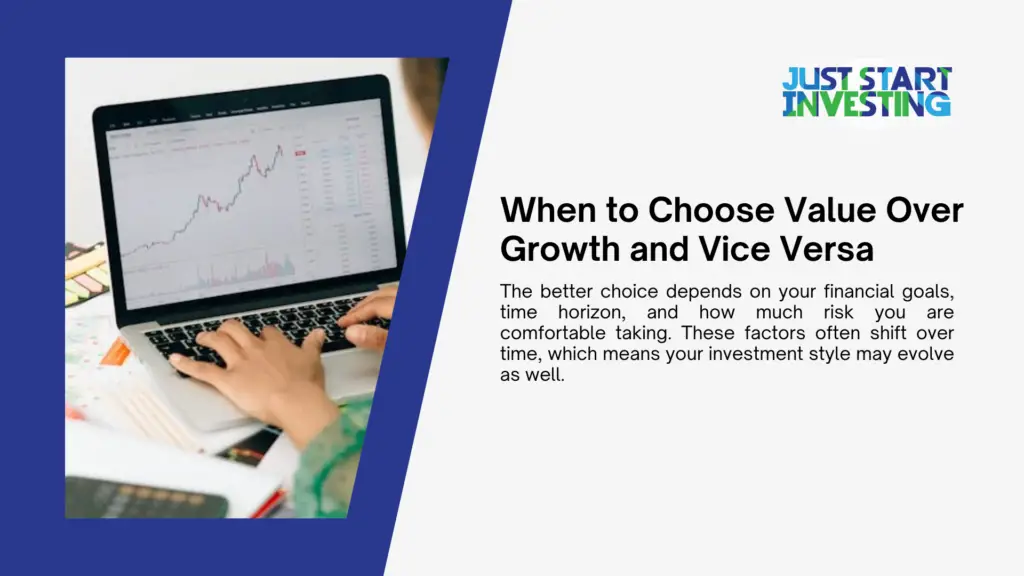Recognizing the difference between growth and value stocks is necessary to make smarter investment choices. Value stocks are often shares of well-known companies that the market considers to be inexpensive and that regularly generate dividend income and stable performance. Growth stocks, on the other hand, are owned by businesses that are anticipated to grow their profits at a faster rate than the market, drawing in investors looking to make long-term capital gains. Each style carries its own risk and reward profile, and the right balance depends on your financial goals, time horizon, and market outlook. The article explores the differences between growth and value companies, their performance in different scenarios, and how investors may use them to create a more robust portfolio.
What You Should Know About Value and Growth Stocks
When deciding how to invest, understanding the difference between value and growth stocks can make your choices more strategic and better suited to your goals. These two stock types represent different business profiles and investor expectations. Value stocks are generally seen as undervalued relative to their fundamentals, while growth stocks are associated with companies aiming to expand rapidly. Both play important roles in portfolio building, depending on your risk tolerance, time horizon, and return objectives. In the sections that follow, we take a closer look at how to identify each type and why knowing the difference matters when shaping a smarter investment approach.
What Defines a Value Stock and How to Identify One
Value stocks are shares of established companies that appear to be trading for less than their actual worth. These companies often face temporary challenges or are in industries that are currently out of favor. They often operate in recognized sectors like manufacturing, utilities, or finance and have lower price-to-earnings ratios and greater dividend yields. Analysts use metrics like the price-to-book ratio and dividend payout to spot undervalued opportunities.
What Defines a Growth Stock and Where to Find Them
Growth stocks are shares in companies expected to grow faster than the overall market. Rather than paying dividends, these businesses usually reinvest their revenues to grow their businesses. They are frequently encountered in industries including healthcare, e-commerce, and technology. Growth stocks tend to have higher valuations and are attractive to investors who prioritize capital appreciation.
Why the distinction matters for investors
Understanding the difference helps align your investments with your financial goals. Growth stocks can offer strong long-term gains but come with more risk. Value stocks may provide greater stability and income. Choosing the right type depends on your risk tolerance and investment horizon.
How Value and Growth Stocks Perform Over Time
Looking at historical performance and market cycles helps investors understand how these stock types behave in different environments. Both can be profitable, but their results often depend on timing and economic conditions.
Performance in bull and bear markets
Growth stocks often perform well in bull markets when investor optimism and low interest rates prevail. However, they can experience steep declines in bear markets. Value stocks usually hold up better during downturns because of their lower valuations and ties to stable businesses.
Long-Term Returns Across Different Market Cycles
Over longer time frames, growth stocks have outperformed during economic booms while value stocks tend to do better in periods of recovery or inflation. The performance leadership often rotates between the two, depending on market sentiment and economic conditions.
Well-Known Examples of Value and Growth Stocks
Value stock examples include companies like Coca-Cola, Procter & Gamble, and JPMorgan Chase. These firms have consistent earnings and stable operations. Growth stock examples include Tesla, Amazon, and Nvidia, which are known for innovation, expansion, and strong revenue growth.
Risks and Rewards of Each Investment Strategy
Both investment styles come with advantages and disadvantages. Understanding the risks and potential returns helps you choose the approach that fits your personal investment profile.
The Risk Profile of Growth Stocks
Growth stocks can be volatile because their valuations rely heavily on future expectations. If a company falls short of projected performance, its stock price can drop sharply. These stocks are also sensitive to rising interest rates, which reduce the present value of expected earnings.
The Risk Profile of Value Stocks
Value stocks may seem safer, but are not without risk. Sometimes a stock is undervalued for valid reasons, such as a declining industry or an outdated business model. These stocks may lag during strong bull markets and carry the risk of becoming value traps.
Which Strategy Offers Higher Potential Returns
Growth stocks offer the chance for larger gains, especially when the company surpasses expectations. Value stocks can deliver solid returns through price appreciation and dividends, especially when the market begins to recognize their true worth.
When to Choose Value Over Growth and Vice Versa

The better choice depends on your financial goals, time horizon, and how much risk you are comfortable taking. These factors often shift over time, which means your investment style may evolve as well.
Aligning Your Choice with Financial Goals
Investors focused on building wealth quickly may favor growth stocks, while those looking for income or capital preservation might prefer value stocks. The stage of life you are in also affects this decision, with younger investors often leaning toward growth and older investors favoring value.
How Broader Economic Trends Affect Each Strategy
Macroeconomic factors play a major role in the performance of each style. Growth stocks tend to shine during periods of low interest rates and strong innovation. Value stocks benefit when interest rates rise, inflation increases, or investors rotate into more defensive sectors.
Making Decisions Based on Risk Tolerance and Age
Risk-averse investors or those nearing retirement may want to emphasize value stocks. Younger investors with longer time horizons may prefer the high-return potential of growth stocks, even if they come with more short-term volatility.
Building a Balanced Portfolio with Both Strategies
Diversifying across both value and growth stocks can help manage risk while capturing different market opportunities. A blended approach is often recommended for long-term stability.
Benefits of a Blended Approach
Combining both strategies provides balance. Growth stocks can lift returns during expansions, while value stocks can reduce losses during downturns. This approach helps smooth out performance across varying conditions.
Sample Portfolio Mixes by Investor Type
Aggressive investors might allocate 70 percent to growth and 30 percent to value. A balanced investor might use a 50-50 mix. Conservative investors may lean toward 70 percent value and 30 percent growth, especially if income or stability is a priority.
When and How to Rebalance Your Portfolio
Over time, your allocation can drift due to market movements. Rebalancing once a year or after major events helps ensure your portfolio remains aligned with your goals. This can be done manually or through automated investment platforms.
The Outlook for Value and Growth Stocks
Market trends change over time, and so do the opportunities within each investment style. Staying informed can help you make timely adjustments and avoid being caught off guard.
What Could Drive Growth Stocks Forward
Sectors like artificial intelligence, renewable energy, and digital platforms are expected to fuel further growth. These areas continue to attract investor interest due to their potential to reshape entire industries.
How Value Stocks May Benefit from Changing Conditions
Companies in energy, financials, and industrials may perform well in environments marked by inflation, interest rate increases, and economic recovery. These factors can prompt investors to return to undervalued segments of the market.
What Analysts Are Saying About Future Opportunities
Experts often recommend a balanced strategy moving forward. While some forecasts favor a resurgence in value investing, others maintain strong outlooks for innovation-driven growth. Most agree that diversification remains a smart and stable approach.

